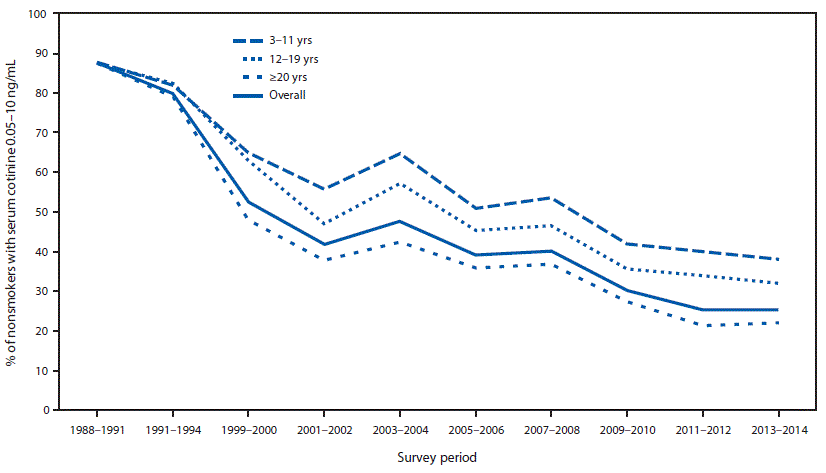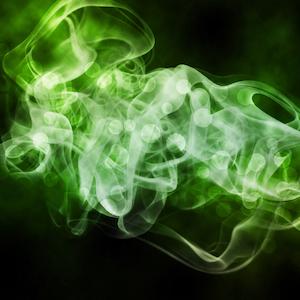I remember the days when a restaurant's seating host would ask, "Smoking or non-smoking?" As if it mattered. The two sections were usually separated by a flimsy little divider that didn't even stretch to the ceiling. The more appropriate question would have been, "Stink or slightly less stink?"
I'm glad those days are behind us. Even though the campaign to ban smoking in public places wasn't based on entirely solid science, there's adequate reason to conclude that restaurant workers and others constantly exposed to secondhand smoke would suffer some ill effects. Besides, it smells bad, and that negative externality is a good enough reason to ban it.
The bans seem to be working. The latest data from the CDC show that the percentage of nonsmokers (aged 3+) who show signs of secondhand smoke exposure (based on serum levels of a molecule called cotinine, a metabolite of nicotine) has collapsed dramatically, from 87.5% in 1988 to 25% in 2014.

Source: CDC
This is very good news. In fact, it's such good news, that some researchers and public health officials have fabricated something new to worry about: Thirdhand smoke.
What on Earth Is Thirdhand Smoke?
Thirdhand smoke refers to all the particulate matter that sticks to the hair and clothes of a smoker. It's the reason that your nose can identify a smoker from a few feet away. Naturally, these residues also tend to cover the walls and floor of a smoker's home.
Are they dangerous? It's going to be nearly impossible to determine that. Any person (e.g., a child) who is routinely exposed to thirdhand smoke is also going to be exposed to secondhand smoke. The latter is far more dangerous than the former, so any harm reduction efforts should be aimed at making sure kids aren't exposed to secondhand smoke.
The libertarian outlet Reason poked fun at the concept of thirdhand smoke in a 2014 article by Brendan O'Neill: "What next—'fourth-hand smoke,' to describe coming into contact with someone who was once in a room in which someone once had a cigarette?"
Don't laugh, Reason. That's exactly where this is headed.
We're a Nation of "Microphobes"
Here is a snippet of an article from Vice: "[T]hat rich, burnt oatmeal smell emanating from grandpa's sweater, is a credible health threat. The takeaway: Don't smoke. Don't hang around smokers. And don't hang around people who hang around smokers." [Emphasis added]
How could somebody say something so stupid? People are afraid of what they can't see; i.e., microscopic things. And since we can't see a lot of things, we're afraid of a lot of things. Call it "microphobia." Germs? Bad. Chemicals? Bad. Pesticides? Bad. If something is tiny and invisible, people think it will probably kill them. Therefore, the leftover particles on grandpa's shirt are probably lethal, too.
We also tend to go looking for risk in places where little exists. People are willing to drive in their (relatively dangerous) cars to Whole Foods to avoid (relatively harmless) GMOs. Likewise, we're now blazing up doobies but fearful of thirdhand smoke. That's just illogical.
Additionally, all of this is tinged with an air of self-righteousness. A YouGov poll showed that 16% of young Americans believe that non-smokers are morally superior to smokers. You shouldn't hang around smokers because they're bad people. Yes, a growing a number of our fellow citizens actually believe that.
The Bottom Line
The increasing concern over thirdhand smoke is the sort of nonsense that must be fought against because it's premised upon our society's bizarre relationship with reality and risk. Not every impure speck in the environment will kill you.
If you want something to worry about, ask yourself why you aren't eating enough fiber. Because, odds are, you aren't.




